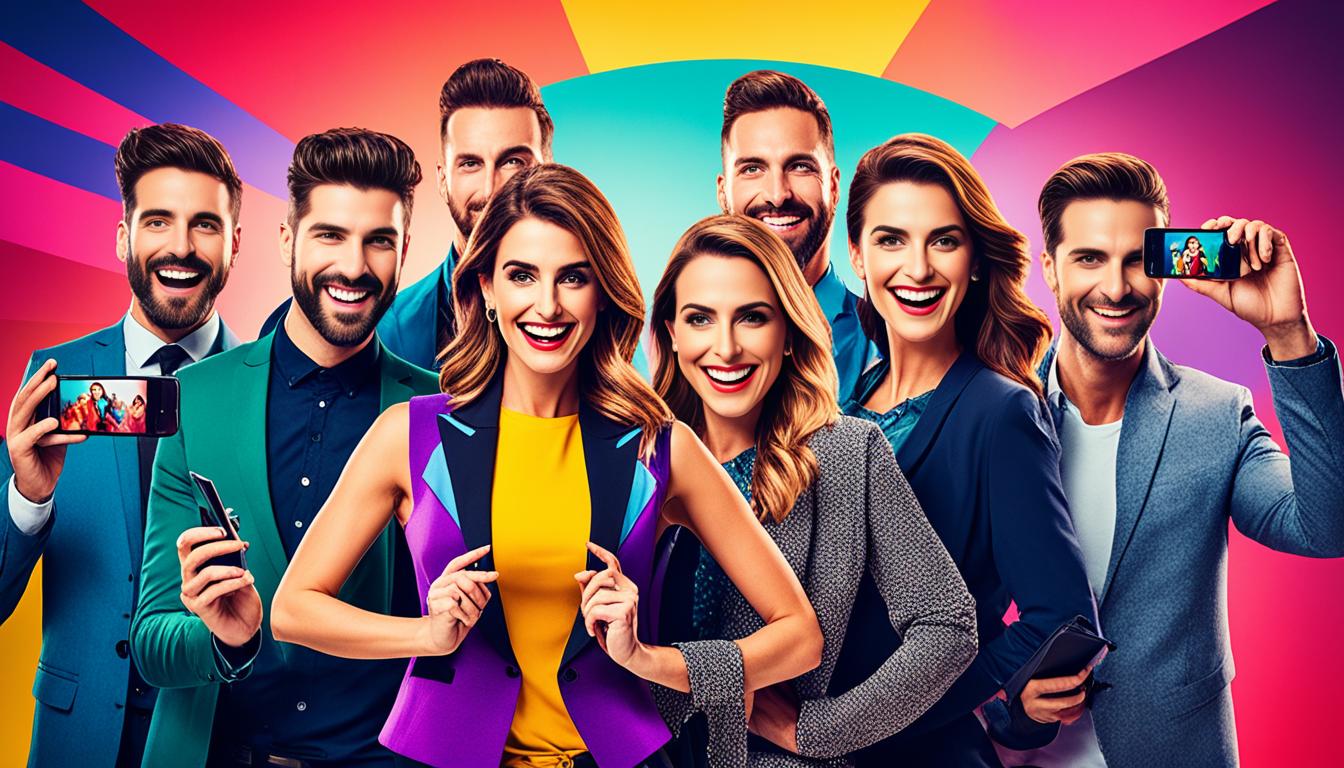Have you ever thought about why brands are now turning to social media influencers instead of old-school advertising ways? In our digital world, influencer marketing is becoming key for businesses. They use it to connect deeply with their customers and to spread the word about their products. With the help of famous people on platforms such as Instagram, YouTube, and TikTok, brands are getting their messages out more widely. This is helping them grow quickly.
Compared to traditional ads that sometimes fall short, influencer marketing is much better at reaching people in a real way. It creates conversations that feel genuine between brands and their customers. Through influencers, brands can fit seamlessly into their customers’ everyday lives. This makes what they have to say more relatable and powerful. This change shows a move from just advertising to actually interacting. It’s all about being real and connecting well now.
Key Takeaways
- Influencer marketing is pivotal for businesses in the digital age.
- Social media influencers play a crucial role in connecting brands with audiences.
- Platforms like Instagram, YouTube, and TikTok are essential for influencer marketing campaigns.
- Influencer marketing offers a more authentic and engaging alternative to traditional advertising.
- Utilizing influential personalities can significantly boost brand growth.
The Rise of Influencer Marketing
In our digital world today, traditional ads are not as powerful as they used to be. This has led to the quick rise of influencer marketing. Social media stars, with lots of followers and trust, are now key in helping brands connect with consumers authentically.
Social media influencers create loyal and trusting audiences who are more likely to be receptive to their recommendations, making influencer collaborations an effective strategy for connecting with potential customers.
But, there’s a big hurdle. Many people doubt the truth of what influencers endorse. So, brands have to carefully pick who they partner with. They need to make sure the match feels real and fits the influencer’s own brand.
By using the trust influencers have built, brands can make real, strong connections. This often works better than old-fashioned ads. Yet, winning over skeptical consumers is essential for this tactic to keep working.
| Influencer Strategy | Key Benefits | Challenges |
|---|---|---|
| Influencer Collaborations | Increased Engagement, Authentic Connections | Consumer Skepticism, Authenticity |
| Social Media Campaigns | Enhanced Reach, Targeted Audience | Maintaining Credibility, Measuring ROI |
Authenticity and Trust in Influencer Marketing
Today, most people doubt traditional ads. So, being real in influencer marketing matters a lot. This method uses content from influencers that really connects with their fans. It boosts trust and gets more people involved.
Why Authenticity Matters
Realness is key in influencer marketing. When influencers share genuine stories, it seems more honest than ads. This makes people trust them. And when people trust influencers, they also trust the brands they talk about. It’s a win-win that leads to stronger connections and better results.
Building Trust with Influencer Content
Influencers win over their followers by sharing content that fits not just their own values but their fans’ too. This creates a vibe of honesty and openness. It’s the heart of good influencer marketing. Content that is real and relatable grows strong communities. And these communities keep engaging with the influencer and the brand over time.
| Key Factors | Impact on Engagement Rates | Influencer Examples |
|---|---|---|
| Authenticity | Increases audience trust | Chiara Ferragni |
| Relatability | Enhances community loyalty | Zach King |
| Consistency | Maintains ongoing engagement | Huda Kattan |
Types of Social Media Influencers
The world of influencer marketing is vast. It has various classes, from macro-influencers with big followings to micro-influencers with smaller, focused audiences. There’s also a group called nano influencers. By understanding these groups, brands can choose the best fit for their goals and strategies.

Macro-Influencers vs. Micro-Influencers
Macro-influencers are famous on social media with huge follower numbers. They offer wide visibility and connect with large groups of people.
Micro-influencers have fewer followers, maybe a thousand to under a hundred thousand. Yet, they often see higher engagement. This is because they connect deeply with their smaller, specific audiences, making them key for focused campaigns.
Nano Influencers and Their Role
Nano influencers have under 1,000 followers. They influence within their immediate, local circles. This authenticity makes them perfect for community or niche market campaigns.
By combining the reach of macro-influencers, the connection of micro-influencers, and the authenticity of nano influencers, brands can develop effective strategies. These strategies can improve reach, engagement, and the bond with audiences.
Choosing the Right Influencer for Your Brand
Finding the right influencer takes careful planning to match your brand with the right personality and audience. It’s key to make sure the influencer’s style fits with your brand’s values. This helps create a story that feels like it just flows together naturally.

| Factors | Considerations |
|---|---|
| Engagement Rates | High engagement rates show the influencer draws in a lot of people who really interact with their posts. Look at how many likes, comments, and shares they get to see if these are real, engaging interactions. |
| Past Collaborations | By looking at the influencers’ previous work, you can see how they have helped other brands. This gives you an idea of how they might help enhance your brand’s image too. |
| Content Style | It’s important to pick influencers whose content style matches yours. This way, when they create, it feels like it naturally speaks to your audience as well. |
| Reputation | The influencer’s reputation can change how people see your brand. It’s best to choose influencers who are well-trusted in their field and have a good standing with the public. |
When reaching out to influencers, don’t just focus on the numbers. Look at the big picture. See how everything connects to tell your brand’s story. This approach can help build real connections with your audience, leading to growth and meaningful engagement for your brand.
Creating Effective Influencer Campaigns
To make influencer campaigns work, planning is key. Brands and influencers need to set clear goals. They also need to work closely together on making content.
Setting Objectives and Goals
Influencer campaigns do best when they have clear goals. These goals help measure success. They must be understandable to both the brand and the influencer. This could be to make the brand more visible, increase sales, or get more people involved. Having these clear goals is vital for success tracking.
Content Creation and Collaboration
Working together on content is vital for a successful influencer campaign. Both the brand and the influencer should join forces to create content that speaks to their audience. Finding the right mix of brand messages and the influencer’s real voice is crucial. It ensures that the content is both authentic and draws people in.

We will look at different types of influencer campaigns to see how they work and what they focus on.
| Campaign Type | Key Features | Benefits |
|---|---|---|
| Product Endorsement | Direct product placement, influencer reviews | Instant brand presence, possible sales increase |
| Content Collaboration | Storytelling, co-created content | True connection, more engaged audience |
| Social Media Takeover | Influencer runs brand’s account for a day | New viewpoint, more social media interaction |
Learning how to use these strategies is important for brands. They can plan and carry out influencer campaigns successfully. Regularly checking and adjusting their strategies can help them get the most out of these partnerships.
Influencer Outreach Strategies
Successful influencer outreach is all about creating strong and long-lasting partnerships. These partnerships should benefit both the brand and the influencer. By following the strategies below, brands can build meaningful relationships with influencers.
“Building long-term influencer partnerships not only enhances brand messaging but also deepens the connection between the influencer and the brand’s audience.”

Building Long-Term Influencer Partnerships
Creating long-term influencer partnerships helps maintain a consistent brand message. It also taps into the trust influencers have from their followers. This consistent collaboration results in a more genuine brand presentation, which drives ongoing engagement and loyalty.
- Identify influencers whose ethos aligns with your brand values.
- Engage in regular and open communication to nurture the relationship.
- Offer exclusive deals and long-term incentives to reinforce the partnership.
Negotiating Collaborations and Agreements
Negotiating clear collaboration agreements is crucial for influencer partnerships to work well. Both the brand and the influencer should clearly know their roles and what’s expected. This clarity leads to a win-win situation for both.
Important points during negotiations are:
- Compensation: Agree on a fair payment that matches the influencer’s influence.
- Content Deliverables: Decide on the type and quantity of content that should be produced.
- Exclusivity: State whether the influencer needs to work exclusively in a certain area.
- Duration: Set a specific timeline for how long the partnership will last.
- Performance Metrics: Lay out how success will be measured.
| Key Aspect | Details |
|---|---|
| Compensation | Fair remuneration aligned with the influencer’s reach. |
| Content Deliverables | Type and frequency of required content. |
| Exclusivity | Agreements on exclusive promotional activities. |
| Duration | Clearly defined partnership timelines. |
| Performance Metrics | Criteria for assessing collaboration success. |
By following these steps, brands can significantly improve their influencer programs. Building strong partnerships with influencers benefits both parties, and these partnerships can last for a long time. Working this way helps brands reach more people and build a strong, loyal fan base.
Maximizing Influencer ROI
To maximize Influencer ROI, careful steps are taken to track and judge the success of influencer marketing. This way, effort and money are put to good use, bringing in big returns.
Measuring the Impact of Influencer Marketing
The first goal is to understand the effects of influencers through detailed analytics. These analytics include stats like how often people interact, how many click the links, and how many take action. They show if a campaign is working.
Setting up a good system to watch these numbers is key for brands. Using the latest tools and software can make these insights even clearer and more useful.
Optimizing Campaign Performance
With the right data, brands can tweak their plans to work better. This means using what they’ve learned to improve things like the quality of what they share and who they work with.
Important steps in this process are:
- Content Adjustment: Making sure what’s shared matches what the audience likes.
- Influencer Selection: Picking influencers whose followers are just right for the brand.
- Timing and Frequency: Posting when it’s best to catch more attention and action.
Let’s look at how changes in these areas could impact how well a campaign does. Here’s a comparison of two make-believe campaigns:
| Campaign Element | Before Optimization | After Optimization |
|---|---|---|
| Engagement Rate | 2.5% | 4.8% |
| Click-Through Rate | 1.2% | 3.5% |
| Conversion Rate | 0.6% | 2.2% |
By carefully watching and improving, brands can really raise their Influencer ROI. This means more people get involved, leading to better sales and success.
Case Studies of Successful Influencer Campaigns
In today’s marketing world, looking at successful campaigns teaches us a lot. We learn the best ways and strategies by seeing what worked for different brands. This helps us know what makes influencer marketing successful.
Parfums de Marly’s Luxury Collaboration
Parfums de Marly worked with top beauty influencers to great success. This partnership made their fragrances a top choice for many. By using these influencers, they got more popular and trusted.
“The partnership with luxury influencers has effectively elevated our brand presence and engaged a broader audience, driving our successful campaigns and long-term growth.” – Marketing Director, Parfums de Marly
Refy Beauty’s Influencer Launch Strategy
Refy Beauty did something smart for their launch. Led by Jess Hunt, they used her followers to introduce the brand. They told real stories and made content that people loved.
This drew many to the brand, and they sold a lot right away.
The following table highlights key metrics from these campaigns:
| Brand | Campaign Focus | Outcome |
|---|---|---|
| Parfums de Marly | Luxury Collaboration | Increased Brand Awareness, Higher Sales |
| Refy Beauty | Influencer Launch Strategy | Rapid Community Growth, Strong Sales |
These examples show how influencer work can lead to big success. By looking at these, brands can figure out their own winning strategies in the market.
Challenges and Pitfalls of Influencer Marketing
Influencer marketing is strong but has its challenges. The biggest hurdle is picking the right influencers. They must match the brand’s values and connect with its audience. If not, the brand’s image may suffer.
A strategic approach is crucial to avoid these issues. Brands should carefully choose influencers. They need to check if they truly reflect the brand and its target market.
Managing brand risks with influencer content is also tough. Unplanned posts can cause various problems, even legal ones.
To lower these risks, clear guidelines and good communication are necessary. Brands and influencers should agree on what’s expected and what’s not within their content.
Let’s look at how good influencer strategies compare to brand risks:
| Effective Strategies | Associated Brand Risks |
|---|---|
| Thorough Research and Vetting | Potential Mismatch with Brand Values |
| Clear Communication and Guidelines | Misinterpretation of Brand Messaging |
| Comprehensive Collaboration Agreements | Legal and PR Concerns |
Using a careful and strategic approach in influencer marketing can solve these issues. It makes influencer marketing powerful without risking a brand’s good reputation.
The Future of Influencer Marketing
The world of influencer marketing is ever-changing. It’s driven by trends and new ways to market products. Staying up to date with what’s next is key for brands to succeed.
Evolving Trends and Innovations
Influencer marketing changes every year. Now, influencers can use AI to understand what their fans like. We’re also seeing digital avatars and virtual influencers getting attention, which is new and exciting.
Live streams and short videos on TikTok and Instagram Reels are big. This makes brands work harder to get people’s interest.
| Trend | Impact on Influencer Marketing | Opportunities |
|---|---|---|
| Digital Avatars | High engagement with younger audiences | New forms of content creation |
| AI-Driven Insights | Personalized content strategies | Enhanced audience targeting |
| Live Streaming | Increased real-time interaction | Immediate audience feedback |
Long-Term Predictions and Strategies
VR is next in influencer marketing, offering immersive brand experiences. Brands will need top analytics tools to check how influencers are doing. This lets them see if it’s all working.
Technology and influencers’ creativity will keep pushing marketing forward. Brands that are smart about their strategies can use this to their advantage. They’ll make the most of new tech and trends.
Conclusion
Today, influencer marketing is key for brands to connect with their audience. It uses the reach and trust of social media stars to boost messages. This helps gain a strong market advantage.
Choosing the right influencer is crucial, which can be from a big star to a small local voice. Selecting influencers that match your brand’s values improves audience connection and trust. This aids in the brand’s long-term growth.
Social media and influencer marketing are always changing. To keep up, brands must adopt new trends. This continual improvement ensures they lead in the digital market, staying competitive.


Leave a Reply